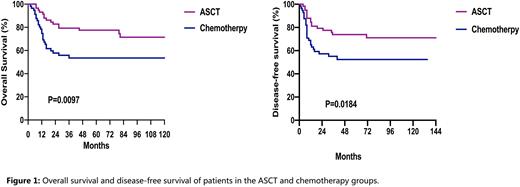Abstract
Introduction: The optimal post-remission therapy (PRT) for patients with favorable and intermediate-risk acute myeloid leukemia (AML) remains uncertain. We retrospectively analyzed and compared the efficacy of high-dose idarubicin plus busulfan conditioning regimen combined with autologous stem cell transplantation (ASCT) and intermediate- to high-dose cytarabine consolidation chemotherapy for post-remission treatment (PRT) in patients with favorable- and intermediate-risk AML.
Methods: A total of 116 patients with favorable- and intermediate-risk AML according to 2022 ELN risk stratification who were treated with ASCT (n=58) or intermediate- to high-dose cytarabine regimen (n=58) were enrolled in this study. All the patients received IA regimen (idarubicin 10-12 mg/m2 on days 1 to 3 and cytarabine 100 mg/m2/d on days 1 to 7) as induction and complete remission (CR) was obtained in all the patients after one course of induction. Fifty-eight patients were subjected to 2-4 courses of intermediate- to high-dose cytarabine (cytarabine 2-3 g/m2 twice daily on days 1-3). High-dose idarubicin plus busulfan conditioning regimen (I-Bu; idarubicin 20 mg/m2 continuous i.v. from days -13 to -11, busulfan in intravenous formulation: 3.2 mg/m2 or oral formulation: 4.0 mg/m2 from day -5 to -2) combined with ASCT was given to the other 58 patients 2-3 courses of intermediate- to high-dose cytarabine and mobilization and collection of peripheral blood stem cells. Clinical outcomes were retrospectively analyzed for patients belonging to the two treatment arms.
Results: The median age was 38 (14-60 years) and 32 years (14-59 years) in ASCT and chemotherapy cohort, respectively. After a median follow-up of 68 months (1-200 months), and the median overall survival (OS) has not been reached in both groups. The 5-year and 10-year OS in the ASCT group was 77.5% and 71.5%, and 5-year and 10-year disease-free survival (DFS) was 73.9% and 71.1%, respectively. The 5-year OS and DFS in the chemotherapy group were 53.5% and 52.4%, respectively. The median OS and DFS of the patients in ASCT group were significantly better than those in chemotherapy group (OS: p=0.009, HR=0.444, CI 0.237 to 0.831; DFS:p=0.018, HR=0.494,CI 0.268 to 0.911). No treatment-related early death (death within 8 weeks after treatment) was observed in the ASCT group. All the patients experienced severe bone marrow suppression and severe (grade 3 or 4) hematological toxicity, and we did not observe severe (grade 3 or 4) cardiotoxic complications during or after ASCT in all the patients.
Conclusions: ASCT with I-Bu regimen is possibly a promising PRT for patients with favorable- and intermediate-risk AML in the first CR, improving prognosis of these patients.
Disclosures
No relevant conflicts of interest to declare.
Author notes
Asterisk with author names denotes non-ASH members.


This feature is available to Subscribers Only
Sign In or Create an Account Close Modal